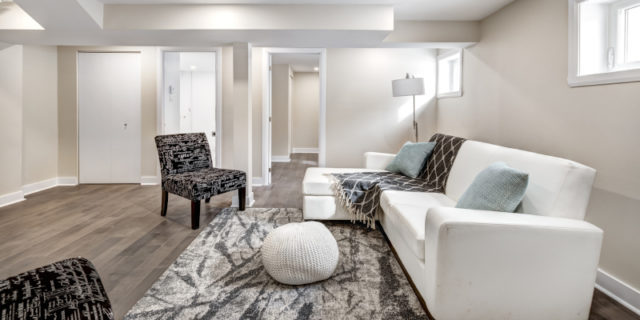When you move into a used home, you will have a lot of questions. You might be wondering about your roof and finding contractors that provide roofing in Sussex County, or wherever you live. Brightening a dark room with no natural light can significantly improve its ambiance and make it a more inviting space. Whether you’re dealing with a basement, an interior room, or a space with small windows, there are several strategies you can employ to lighten up such areas. Here’s a comprehensive guide to help you transform your dimly lit room into a brighter and more welcoming space.
1. Choose the Right Paint Colors:
Paint color plays a crucial role in brightening a dark room. Lighter colors like white, cream, soft pastels, and light grays can reflect more light and create a sense of airiness. Consider painting both the walls and ceilings in these light shades to maximize the effect.
2. Use Reflective Surfaces:
Incorporate materials and finishes that reflect light. Mirrors, glass, polished metals, and glossy tiles can bounce light around the room, making it feel more spacious and brighter. Hang large mirrors strategically to reflect light from any available sources.
3. Optimize Lighting:
Proper lighting is essential in dark rooms. Here are some lighting strategies to consider:
- Ambient Lighting: Install overhead lighting fixtures like chandeliers, pendant lights, or recessed lighting to provide overall illumination. Choose fixtures with a design that complements your room’s style.
- Task Lighting: Use task-specific lighting such as table lamps, floor lamps, or under-cabinet lights to brighten specific areas like reading nooks or workspaces.
- Layered Lighting: Combine ambient, task, and accent lighting to create a well-balanced lighting scheme that suits different purposes and moods.
- LED Bulbs: Opt for energy-efficient LED bulbs with a daylight or cool white color temperature to mimic natural light.
- Dimmer Switches: Install dimmer switches to adjust the lighting intensity according to your needs and preferences.
4. Light-Colored Flooring:
Light-colored flooring, such as light wood, light-colored carpet, or light-colored tiles, can help brighten a room by reflecting light. Avoid dark or heavily patterned flooring, as they tend to absorb light and make the space feel darker.
5. Minimalistic Furniture:
Choose furniture that is light in color and doesn’t overwhelm the room. Light-colored upholstery, such as white, beige, or light gray, can help create a sense of openness. Consider furniture with legs to allow light to pass underneath, giving the impression of more space.
6. Remove Heavy Drapes:
If your room has windows, opt for lightweight curtains or blinds that let in as much natural light as possible. Avoid heavy or dark-colored drapes that block light. Alternatively, you can leave windows uncovered to maximize natural light.
7. Decorate with Light Accessories:
Incorporate light and reflective accessories like glass vases, mirrored picture frames, and metallic accents. These elements can add a touch of sparkle and enhance the overall brightness of the room.
8. Open Shelving:
Consider open shelving instead of closed cabinets. This not only adds a sense of openness but also allows light to pass through, making the room feel brighter. Be sure to keep the shelves organized and clutter-free.
9. White or Light-Colored Ceiling:
Paint the ceiling white or a light color to help bounce light throughout the room. A lighter ceiling can give the illusion of a higher ceiling, making the room feel more spacious.
10. Artificial Sunlight:
If natural light is entirely unavailable, consider using light therapy lamps that mimic natural sunlight. These lamps can improve mood and help combat feelings of darkness and gloominess in the room.
11. Use Light-Colored Accessories:
Decorate the room with light-colored throw pillows, rugs, and artwork. These accents can add pops of brightness and contrast to the space.
12. Keep It Clutter-Free:
A cluttered room can feel even darker and more cramped. Regularly declutter your space to maintain a clean and open environment. Consider multi-purpose furniture with built-in storage to help keep things organized.
13. A Touch of Greenery:
Introduce indoor plants that thrive in low-light conditions, such as snake plants, pothos, or peace lilies. Not only do they add a touch of nature, but they can also improve air quality and brighten up the room with their lush foliage.
14. Wall Decor:
Hang artwork or decorative mirrors strategically to draw the eye upward and create visual interest. Large, light-colored pieces of art can become focal points that enhance the overall brightness of the room.
15. Regular Maintenance:
Lastly, keep windows and artificial light fixtures clean to ensure they provide the maximum amount of light. Dust and dirt can accumulate over time and reduce the effectiveness of your lighting sources.
In conclusion, transforming a dark room with no natural light into a brighter, more inviting space is achievable with careful planning and the right design choices. By selecting light colors, optimizing lighting, and incorporating reflective surfaces and decor, you can create a welcoming atmosphere that feels open and airy, even in the absence of natural light. Remember that the key to success is a well-thought-out combination of these strategies tailored to your specific space and preferences.






